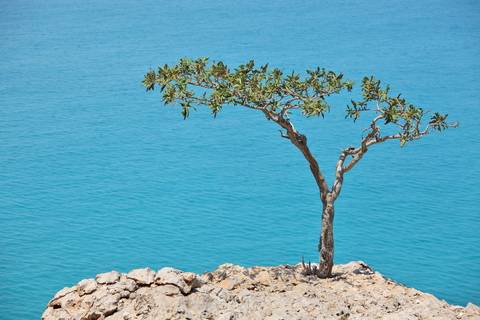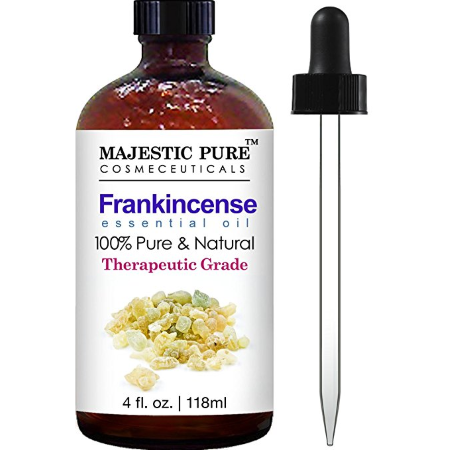Frankincense (oblibanum) has been valued for eons for its spiritual and medicinal properties as well as its fragrance. There is significant scientific evidence proving the many therapeutic effects of frankincense essential oil. In fact, there are so many benefits this oil provides, it boggles the mind. This is definitely one of those oils we should all have on hand.
Where does frankincense essential oil come from?
The best frankincense essential oil originates from the resin of Boswellia sacraa shrub-like tree growing in the southeast Arabian Peninsula in Dhofar and Hadramauth. Boswellia carterii from Somalia and Yemen is listed as a separate species in some papers. However, the consensus appears to be that carterii and sacra are one in the same.
Two less favored species for their therapeutic properties include Boswellia serrata and Boswellia frereana. They come from India and from Somalia respectively. Boswellia frereana may not be at the top of the list for its therapeutic value, but it’s tops if you are making perfumes.
The very best frankincense essential oil in the past and still today comes from Hasik, an inland region of Dhofar.
Chemistry of healing
There is a difference in the chemical composition of frankincense essential oils depending on the species. For instance, Boswellic acids are the main healing constituents of frankincense essential oils. Sacra has the highest concentration (42%) while frereana comes in at only 2% – 3%. However, frereana is priced the highest because it’s valued most for its fragrance. In one study, the concentration of Boswellic acid in sacra tested at 42% while that of carterii was 40% (an argument for listing them as separate species).
Sesquiterpenes are other healing components of Boswellia species. They are found in all species of true frankincense with 16 sesquiterpenes in B. sacra.
If the chemist in you would like to investigate this further, I recommend reading “Phytochemical Analysis of the Essential Oil from Botanically Certified Oleogum Resin of Boswellia sacra (Omani Luban)” by Ahmed Al-Harrasi and Salim Al-Saidi. You can find it at www.mdpi.org/molecules.
History of frankincense
The use of frankincense dates back to earliest recorded history. It is cited numerous times in the Christian Bible and is referenced in ancient Egyptian texts. It is mentioned in Ebers Papyrus (1500 BC) which is one of the oldest known medical records. It was found in King Tutankhamen’s tomb and was still viable.
The ancient people considered frankincense so valuable that for over 3000 years its cost was 5 to 10 times that of gold.
Why the high value
Once you start looking into the therapeutic benefits of frankincense essential oil, you can appreciate why such high value was placed on it.
- Antibacterial
- Antifungal
- Immune system stimulant
- Anti-inflammatory
- Anti-leukotriene Leukotrienes are immune system molecules responsible for inflammation in asthma and bronchitis.
- Anti-acetylcholinesterase – improves cognitive function
- Anticancer
Modern uses
- A recent study indicates frankincense may effectively treat bladder cancer. Another study indicated that frankincense destroyed leukemia cells. It’s important to note here that only 6.7 cancer cases per 10,000 (2008) were reported in Oman compared to 49 cancer cases per 10,000 in the US (2009).
- Frankincense repairs DNA
- Frankincense may be a nontoxic replacement for steroids.
- One study indicates frankincense protects against hepatitis
- Frankincense lowers cholesterol by about 38%
- Frankincense essential oil is documented to regenerate cartilage and bone. It is an effective therapy for arthritis, particularly osteoarthritis.
- It’s an effective in treating asthma, bronchitis and other inflammatory breathing disorders.
- Frankincense essential oil treats Crohn’s disease and colitis.
How to use Frankincense essential oil
- Rub a couple of drops of frankincense essential oil on the bottom of your feet, on your chest or behind your ears. Be sure to do a patch test first to be sure you don’t have an allergy response.
- Add to oils, lotions and creams. Substitute frankincense oil for other oils in your recipes.
- Add a few drops to bathwater for a divine bathing experience.
- Mix a few drops with your favorite carrier oil for awesome massage oil.
- It can also be taken internally, however you should work with a certified aroma therapist if you choose to use the oil in this way.
Conclusion
It never ceases to amaze me as to how many benefits there are associated with essential oils. Mother Nature outdid herself in providing us with the therapies we need for all our ailments. It’s our job to protect her medicine chest by giving her botanicals the right conditions to proliferate and then take care not to abuse her gifts by indiscreet harvesting.
Now go have fun and relax.



You might be interested in checking out this NCBI report: http://www.ncbi.nlm.nih.gov/books/NBK92774/
You are absolutely correct, there is no boswellic acid components (triterpenes) from the steam distillation of frankincense essential oil. I have used a looser definition of the oil to include CO2 distillation which can produce an oil with both alpha and beta boswellic acids.
I should have been more clear in the post and for that I apologize. Thank you for drawing my attention to the omission. However, in my defense, a number of studies using alternate distillation processes refer to the resultant product as “essential oil.” Those that are the purists among us claim that an oil can not be termed an “essential oil” unless it is hydro-distilled or cold pressed. They are correct to hold to this standard definition.
Looks like I owe our readers another frankincense post explaining in more detail the various distillation methods and the chemical properties of each.
Correcting myself, I said herb, I meant Resin…. sorry…
I love this herb! I burn it Frankincense and Myrrh incense constantly in my home and just the fragrance alone is wonderful!